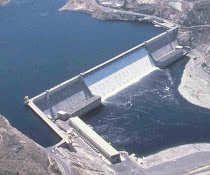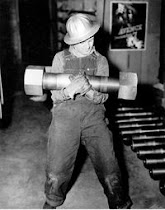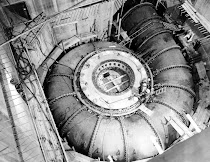Sailing Crazy!
Mrs. Wonacott
18 Apr. 2008.
Pathfinder
There are many conditions that have to be present for a hydroelectric power plant to be built. First, you have to have very solid bedrock beneath the site to support the weight of the dam. The rock must be almost crack free and a fair distance away from any fault lines. This is so that if there is an earthquake, the dam will not shift or crack, causing a flood or other damage. Also, the river that will be dammed has to have a consistent streamflow. This means that there has to be enough water coming into the reservoir to match the amount of water passing through the turbines; otherwise the reservoir will drain. Another important condition that has to be present at the site is a considerable vertical change in the river. Without this change, there would be nowhere to build the dam. The reservoir would be virtually non-existent, and there would be no water pressure to move the turbines, eliminating the usefulness of the dam.
The turbines are probably the most important part of the project, because without them, the rest of the system would be useless. There are two types of turbines in use today: the impulse turbine and the reaction turbine. An old waterwheel at a flourmill is a very basic example of an impulse turbine. They simply use the kinetic energy from a high-speed jet of water hitting a series of buckets on the outside of a wheel to turn the generator to produce electricity. This style of turbine is used for dams with a head (elevation change) of 1000 feet or more.
The reaction turbine is a much more common design than the impulse turbine. In a reaction turbine, water completely fills the passageways that lead to and from the turbine itself. First, the water comes down the pipes from the reservoir (penstock), and is directed into the scrollcase at a very high velocity, where it turns the turbine blades until it runs out of energy. It then falls down through the draft tube at a low velocity into the tailrace, which is the water in the river directly downstream of the dam. There are several different designs available for a reaction turbine. These include “Francis” turbines, “Kaplan” turbines, and Axial Flow turbines.
The Francis Turbine was invented by James B. Francis in 1847. This form of turbine is generally used with 300 to 1000 foot heads, but it can be greater. They are capable of producing up to 250 Megawatts. The Kaplan Turbine was invented by Viktor Kaplan in 1913. Kaplan turbines are used for heads of under 100 feet, and usually have adjustable blades to create the maximum efficiency available with the varying inflow of water. Axial Flow turbines are similar to Francis turbines, but they are enclosed in the penstock, kind of like a propeller blade in a pipe. Also, Axial Flow turbines are used in Pump Storage plants, whereas Francis and Kaplan turbines aren’t.
Pump Storage plants are one of two forms of hydroelectric power plants, but they plants have one specialty: they can go in reverse. These plants have basically one purpose, which is to produce electricity at the peak demand, or when electricity is most expensive. To do this, they have two large pools. When electricity is at peak demand, they run water down through the turbines, generating electricity, which they sell to the customer. When electricity is cheaper, or at off-peak demand, they reverse the turbines and turn them into pumps by sending electricity into the generator, which then functions as a motor, spinning the turbine in reverse and pumping the water from the lower reservoir to the upper reservoir.
Unlike Pumped Storage plants, a conventional plant only has one reservoir. Conventional plants retain the water coming into the reservoir, then steadily release the water downstream. This style of project has many advantages besides just hydroelectricity. Dams can help maintain a steady river level, by controlling how much water is sent downstream through the turbines and spillways. Also, the reservoirs can provide a good and consistent environment for the local wildlife, as well as providing recreational parks. These reservoirs are also used for irrigation of nearby farms. The Grand Coulee Dam, for example, provides irrigation for over 500,000 acres of farmland.
A hydroelectric power plant has many positive and negative effects on the environment. Unfortunately, the creation of a reservoir floods the river valley far upstream of a dam. This means that fertile farmland is sometimes flooded, and plants, animals, and families are displaced. For example, when Mossyrock Dam was built on the Cowlitz River in 1968, the town of Riffe and the community of Kosmos were displaced to make room for the reservoir, which was later renamed Riffe Lake. On a larger scale, the Three Gorges Dam being constructed in
Most people obviously don’t think that hydropower is green, because it was turned down when











